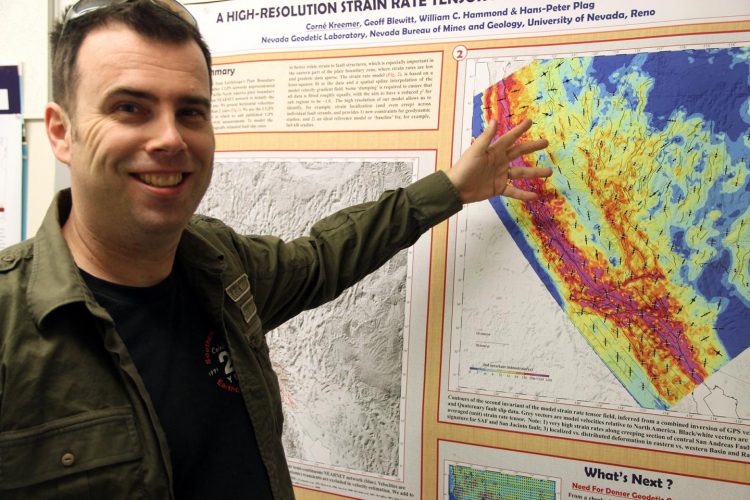Study shows tectonic plates not rigid, deform horizontally in cooling process

Corné Kreemer, associate professor in the College of Science at the University of Nevada, Reno, conducts research on plate tectonics and geodetics. His latest research shows that oceanic tectonic plates deform due to cooling, causing shortening of the plates and mid-plate seismicity. Credit: Photo by Mike Wolterbeek, University of Nevada, Reno
The puzzle pieces of tectonic plates that make up the outer layer of the earth are not rigid and don't fit together as nicely as we were taught in high school.
A study published in the journal Geology by Corné Kreemer, an associate professor at the University of Nevada, Reno, and his colleague Richard Gordon of Rice University, quantifies deformation of the Pacific plate and challenges the central approximation of the plate tectonic paradigm that plates are rigid.
Using large-scale numerical modeling as well as GPS velocities from the largest GPS data-processing center in the world – the Nevada Geodetic Laboratory at the University of Nevada, Reno – Kreemer and Gordon have showed that cooling of the lithosphere, the outermost layer of Earth, makes some sections of the Pacific plate contract horizontally at faster rates than other sections. This causes the plate to deform.
Gordon's idea is that the plate cooling, which makes the ocean deeper, also affects horizontal movement and that there is shortening and deformation of the plates due to the cooling. In partnering with Kreemer, the two put their ideas and expertise together to show that the deformation could explain why some parts of the plate tectonic puzzle didn't fall neatly into place in recent plate motion models, which is based on spreading rates along mid-oceanic ridges. Kreemer and Gordon also showed that there is a positive correlation between where the plate is predicted to deform and where intraplate earthquakes occur. Their work was supported by the National Science Foundation.
Results of the study suggest that plate-scale horizontal thermal contraction is significant, and that it may be partly released seismically. . The pair of researchers are, as the saying goes, rewriting the textbooks.
“This is plate tectonics 2.0, it revolutionizes the concepts of plate rigidity,” Kreemer, who teaches in the University's College of Science, said. “We have shown that the Pacific plate deforms, that it is pliable. We are refining the plate tectonic theory and have come up with an explanation for mid-plate seismicity.”
The oceanic plates are shortening due to cooling, which causes relative motion inside the plate, Kreemer said. The oceanic crust of the Pacific plate off shore California is moving 2 mm to the south every year relative to the Pacific/Antarctic plate boundary.
“It may not sound like much, but it is significant considering that we can measure crustal motion with GPS within a fraction of a millimeter per year,” he said. “Unfortunately, all existing GPS stations on Pacific islands are in the old part of the plate that is not expected nor shown to deform. New measurements will be needed within the young parts of the plate to confirm this study's predictions, either on very remote islands or through sensors on the ocean floor.”
This work is complementary to Kreemer's ongoing effort to quantify the deformation in all of the Earth's plate boundary zones with GPS velocities – data that are for a large part processed in the Nevada Geodetic Laboratory. The main goal of the global modeling is to convert the strain rates to earthquake forecast maps.
“Because we don't have GPS data in the right places of the Pacific plate, our prediction of how that plate deforms can supplement the strain rates I've estimated in parts of the world where we can quantify them with GPS data,” Kreemer said. “Ultimately, we hope to have a good estimate of strain rates everywhere so that the models not only forecast earthquakes for places like Reno and San Francisco, but also for places where you may expect them the least.”
The abstract of the article can be found here: http://geology.gsapubs.org/content/early/2014/08/14/G35874.1.abstract
Founded in 1874 as Nevada's land-grant university, the University of Nevada, Reno ranks in the top tier of best national universities. With nearly 20,000 students, the University is driven to contribute a culture of student success, world-improving research and outreach that enhances communities and business. Part of the Nevada System of Higher Education, the University has the system's largest research program and is home to the state's medical school. With outreach and education programs in all Nevada counties and home to one of the largest study-abroad consortiums, the University extends across the state and around the world.
For more information, visit http://www.unr.edu
Media Contact
All latest news from the category: Earth Sciences
Earth Sciences (also referred to as Geosciences), which deals with basic issues surrounding our planet, plays a vital role in the area of energy and raw materials supply.
Earth Sciences comprises subjects such as geology, geography, geological informatics, paleontology, mineralogy, petrography, crystallography, geophysics, geodesy, glaciology, cartography, photogrammetry, meteorology and seismology, early-warning systems, earthquake research and polar research.
Newest articles

Properties of new materials for microchips
… can now be measured well. Reseachers of Delft University of Technology demonstrated measuring performance properties of ultrathin silicon membranes. Making ever smaller and more powerful chips requires new ultrathin…

Floating solar’s potential
… to support sustainable development by addressing climate, water, and energy goals holistically. A new study published this week in Nature Energy raises the potential for floating solar photovoltaics (FPV)…

Skyrmions move at record speeds
… a step towards the computing of the future. An international research team led by scientists from the CNRS1 has discovered that the magnetic nanobubbles2 known as skyrmions can be…




















